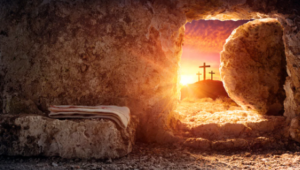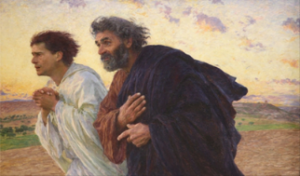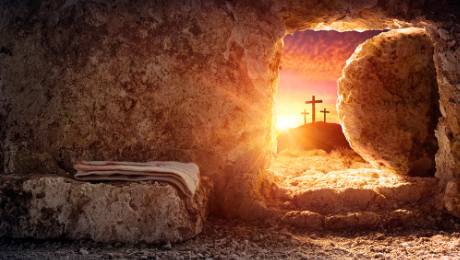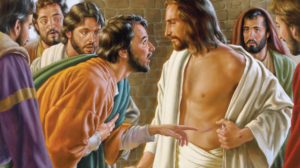
Miracle of Miracles!
Think of how physically and emotionally exhausted the disciples must have been. As if walking throughout Canaan for the last three years (possibly over 4000 miles!) wasn’t enough, now they have walked with Jesus ![]() through the horrific events of the last few days of His trials and crucifixion. As we come to John 20, they have buried their precious Savior in the tomb, and now Mary Magdalene returns early Sunday morning along with Salome and Joanna to anoint Jesus’ body with spices.
through the horrific events of the last few days of His trials and crucifixion. As we come to John 20, they have buried their precious Savior in the tomb, and now Mary Magdalene returns early Sunday morning along with Salome and Joanna to anoint Jesus’ body with spices.  When they saw that the large stone closing off the tomb was moved aside, they were startled and fearful, and humanly they would have thought that Jesus’ body had been stolen . However they must have quickly realized they were witnessing the incredible work of of God, as the angel sitting on the stone told them “He is not here, He is risen!” (see Mk. 16:3-6 for more of how things happened at this wonderful revelation).
When they saw that the large stone closing off the tomb was moved aside, they were startled and fearful, and humanly they would have thought that Jesus’ body had been stolen . However they must have quickly realized they were witnessing the incredible work of of God, as the angel sitting on the stone told them “He is not here, He is risen!” (see Mk. 16:3-6 for more of how things happened at this wonderful revelation).
Think back through the Bible of all of the amazing accounts of God’s marvelous works in our world. Now at the empty tomb, the prophet’s words echo in victory — “The LORD has made bare His holy arm in the eyes of all the nations, and all the ends of the earth shall see the salvation of our God (Isa. 52:10). God has brought about in the resurrection of Jesus Christ the “determining” event of His Redemption Plan. Nothing can compare to the events we will look at in these last two chapters of John’s Gospel. Read them carefully and treasure the moments the disciples share with us as they discover personally just how great our Savior is.

John 20:1-18 – Run!
The Resurrection was regarded as an “immutable” fact by First Century Christians. Not only is it the most treasured fact of our faith, but it is also the most signifcantly witnessed and documented truth and the ![]() greatest miracle of the Bible. Consider for example the elevated doctrinal presentation of the Resurrection given by Paul in 1 Cor. 15. In order to properly study this great event, you are encouraged to begin by reading the Resurrection Day accounts in each Gospel: Matt. 28:1-8; Mk. 16:1-11; Lu. 24:1-12; Jn. 20:1-25. John’s Gospel is unique in its extended emphasis on the resurrection and following events. When the angel
greatest miracle of the Bible. Consider for example the elevated doctrinal presentation of the Resurrection given by Paul in 1 Cor. 15. In order to properly study this great event, you are encouraged to begin by reading the Resurrection Day accounts in each Gospel: Matt. 28:1-8; Mk. 16:1-11; Lu. 24:1-12; Jn. 20:1-25. John’s Gospel is unique in its extended emphasis on the resurrection and following events. When the angel  made that amazing declaration “He is Risen”, the ladies immediately ran back to the disciples to tell them men the amazing news, and Peter and John immediately ran back to the tomb and confirmed the ladies’ fear-filled joy, although they also noted the carefully placed burial cloths. The amazing truths which the disciples are about to see and hear in the coming days will do much more than just explain those burial cloths. He is Risen indeed! The amazing truths which the disciples are about to see and hear in the coming days will do much more than just explain those burial cloths. He is Risen indeed!
made that amazing declaration “He is Risen”, the ladies immediately ran back to the disciples to tell them men the amazing news, and Peter and John immediately ran back to the tomb and confirmed the ladies’ fear-filled joy, although they also noted the carefully placed burial cloths. The amazing truths which the disciples are about to see and hear in the coming days will do much more than just explain those burial cloths. He is Risen indeed! The amazing truths which the disciples are about to see and hear in the coming days will do much more than just explain those burial cloths. He is Risen indeed!
Jesus had had been telling His disciples that He was going to suffer and die, but that He would also rise again – e.g. Jn 2:19; Matt 16:21; Mk 8:31; 9:31; Lu 9:22. They had struggled to believe Him (Matt. 16; Lu. 9; Jn. 16:17-20), and when In John 20:3-10, they heard the ladies’ report of the empty tomb, Peter and John lost no time running back to the tomb wondering “could it be true?”. The house the disciples were gathered in was very possibly in Bethany around on the other side of the Mt. of Olives from the tomb, so that would have been about a two-mile run. John was younger so he got there quicker but humbly stopped at the tomb’s opening. Peter… well, he just rushed right in! The gravecloths used to wrap Jesus’ body were neatly folded in place where He had been laying (note the difference with Lazarus a s he came out of his tomb wearing the gravecloths). They had witnessed the Messiah’s first miracle in Cana. Now they see His greatest miracle. They saw Him die – now they are witnessing Him alive again. They were soon going to understand that Jesus didn’t even need the stone rolled away – that was done to help them grasp the reality of what had happened, so that they would “see and believe”.
s he came out of his tomb wearing the gravecloths). They had witnessed the Messiah’s first miracle in Cana. Now they see His greatest miracle. They saw Him die – now they are witnessing Him alive again. They were soon going to understand that Jesus didn’t even need the stone rolled away – that was done to help them grasp the reality of what had happened, so that they would “see and believe”.
Jesus’ first appearances to witnesses of His resurrection are filled with emotion. In Jn. 20:1-10, Mary & the other ladies came to the tomb early Sunday morning to finish caring for Jesus’ body since it had been rushed to burial the night before. After discovering the open tomb, Mary was left alone at the tomb, emotionally crushed, probably on her knees looking into the tomb, too weak to move. She sees the two angels, they speak tenderly to her, but her anguish shows through in v.15, “Sir, if you have carried Him away, tell me where you have laid Him, and I will take Him away.” And then she turns around and sees Jesus standing there – wow, her tragic sorrow immediately became overwhelming joy! Then He said her name, she heard His voice and knew it was really Him. Just one word said by each – “Mary… Rabboni” That scene holds a special place in the heart of all Christians through all the ages, and it is viewed by many as being one of the most significant instances of overwhelming recognition in all the world’s literature. Note that Mary’s special joy should remind each of us of the moment we encountered Jesus Christ and believed in Him as our Savior!
Jesus Post-Resurrection Appearances
The Gospels tell us about at least nine specific appearances by the Lord through the 40 days starting with Resurrection Sunday.
- On the First Day, Resurrection & Revelation
- 20:1-10, Peter, John & the ladies
- 20:11-18, Mary – All four Gospels review these early first events of the Resurrection. According to Answers in Genesis, by piecing together these four accounts, we learn that there were at least five women who went to the tomb that morning: Mary Magdalene, the other Mary (the mother of James?—Matthew 28:1), Salome (Mark 16:1), Joanna, and the other women (Luke 24:10, the “other women” included Salome and at least one unnamed woman).
- 20:19-23, the Disciples
- 20:24-29, Thomas

- Easter afternoon, A New Companion for Life
- The two disciples on the Emmaus road (Lu. 24:13-32)
- Lu. 24:34, alone with Peter, but no details
- Easter evening
- To about 12 disciples excluding Thomas (Mk.16:14; Lu. 24:36-43; Jn. 20:19 – 23)
- The following Sunday
- To 11 disciples including Thomas (Jn. 20:26-28)
- To seven disciples by the Sea of Galilee (Jn. 21:1-23)
- Add to those nine many other appearances through the next 32 days:
- To 500 people including the Eleven at a mountain in Galilee (Matt. 28:16-20; 1 Cor. 15:6)
- To Jesus’ half-brother James (1 Cor. 15:7)
- To the disciples in Jerusalem (Lu. 24:44-49; Acts 1:3-8; 1 Cor. 15:7)
- The final appearance at His Ascension back to heaven to His Father’s right hand
- To the disciples on the Mount of Olives (Mk. 16:19-20; Lu. 24:50-53; Acts 1:9-12)
![]() Bible Study Journal
Bible Study Journal
-
- One of the exciting and beneficial ways we can study the resurrection of the Lord Jesus is to consider how this event fulfilled prophecy. Take the time to look up each of these prophecies and write some notes from each about what you can learn about Jesus’ resurrection.
- Lev. 23:11
- Psa. 16:10-11; 110:1, 4
- Isa. 53:11-12
- Hosea 6:2
- Also compare Acts 2:24-31; 1 Cor. 15:3-7
- The unbelieving world has to call Christ’s resurrection a hoax. We know the Bible is valid book of history, so what do we know from John 20 that validates Jesus’ resurrection? What are the implications of Jn. 20:8 and 9?
- Phil. 2:9-11 speaks of the exaltation of Jesus which God has now accomplished. Examine what more you can learn about Jesus Christ’s exaltation from Eph. 1:20-23; Heb. 5:9-10; 9:15, 24; 10:12.
- In Heb. 1:1-4, the writer speaks of how Jesus Christ was already and eternally God, and He revealed the One True God to mankind when He came to earth – He was a complete and full expression of God. However, what does Heb. 1:3 tell us happened when Jesus’ mission on earth was completed?
- How would you say John 20:30-31 summarize John’s Gospel?
- One of the exciting and beneficial ways we can study the resurrection of the Lord Jesus is to consider how this event fulfilled prophecy. Take the time to look up each of these prophecies and write some notes from each about what you can learn about Jesus’ resurrection.




